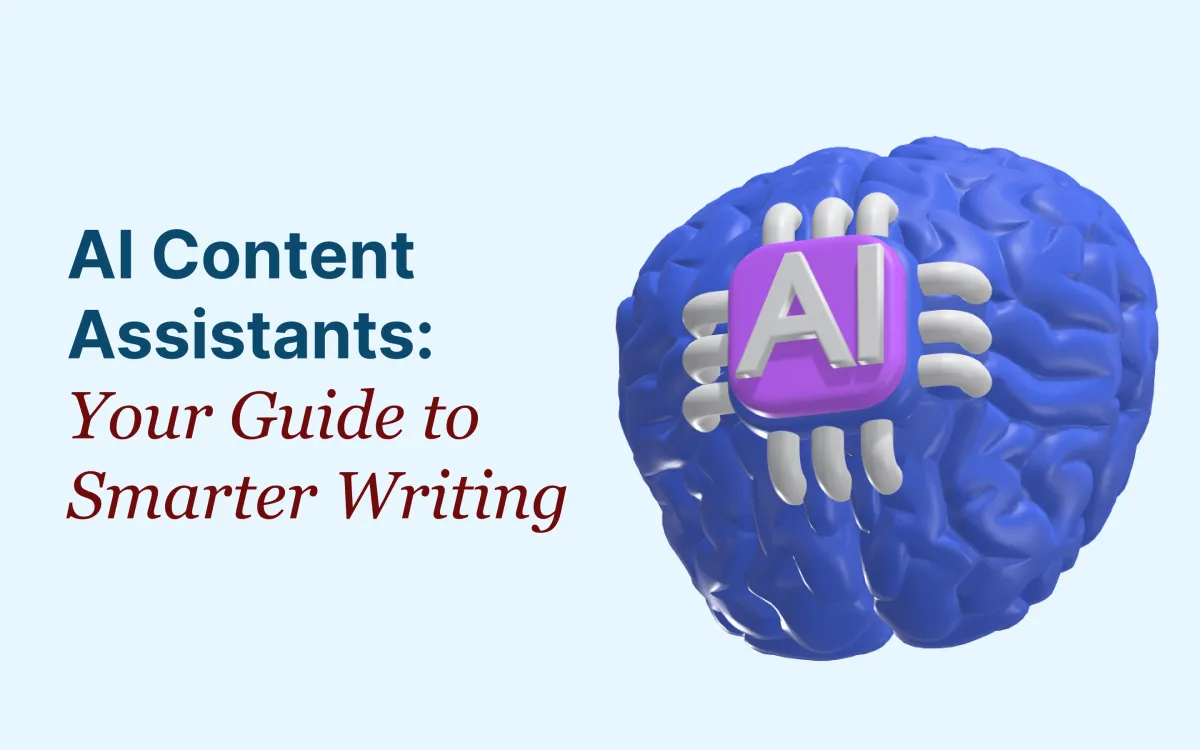AI Content Assistants: Your Guide to Smarter Writing
Discover how AI Content Assistants enhance your writing process. Learn how these smart tools create, edit, and manage content efficiently and effectively.

What Are AI Content Assistants and Why Are They So Important Today?
Have you ever wondered how companies manage to keep up with the need for constant, engaging content online? AI content assistants are the secret. AI Content Assistants are smart tools that use artificial intelligence to help create, adjust, and manage digital content everywhere from social media to websites.
AI content assistants are powered by technologies that help them understand and create text that sounds human. This makes them incredibly useful for a range of tasks, from writing simple emails to putting together detailed reports.
AI Content Assistants tools are vital in today's digital world because they help businesses stay efficient. They automate routine writing tasks, ensure the content is consistent and correct, and help produce large amounts of content quickly. This helps companies keep their online presence strong, connect with customers around the globe, and stay ahead in a competitive market. By helping with tasks like creating personalized marketing emails or generating reports, AI content assistants enable businesses to keep a steady flow of high-quality and engaging content.
Foundations of AI Content Assistants

AI content assistants are built on two main technologies: Natural Language Processing (NLP) and Machine Learning (ML). These technologies work together to help the assistants understand and create text just like a human would.
a. Natural Language Processing (NLP)
Natural Language Processing is what allows these AI tools to read and understand human language. Imagine you're talking to a friend and you mention that you're "feeling blue" today. Your friend understands that you're feeling sad, not that you've turned the color blue.
Natural Language Processing gives AI content assistants a similar ability to interpret what words mean in different contexts. This is crucial for tasks like answering customer questions or summarizing information accurately.
b. Machine Learning (ML)
Machine Learning is all about learning from examples. The more data the AI system is exposed to, the better it gets at its job. For AI content assistants, this means learning from a vast amount of text data to generate new content that feels natural and engaging.
For example, if an AI has been trained on many high-quality articles, it can learn how to structure sentences and rewrite sentences, use appropriate words, and follow logical flows in writing. This helps the AI generate new content that makes sense and holds the reader's attention.
Core Technologies and Models of AI Content Assistant

AI content assistants rely on some advanced technologies and models to function effectively. These include transformer architectures, language models, and text generation techniques. Let's explore these concepts in simpler terms.
a. Transformer Architectures
Transformers are a type of design used in AI that helps machines understand the order and context of words in sentences. Unlike older methods that processed words one by one, transformers look at entire sentences all at once.
This helps them understand how words relate to each other across different parts of the sentence, making the AI more effective at understanding and generating language. For instance, in the sentence "I watched the dog because it was cute," the transformer helps the AI recognize that "it" refers to "the dog."
b. Language Models
Language models are like the brain of AI content assistants. They are trained on vast amounts of text data and learn how to predict what word comes next in a sentence.
Two popular examples are GPT (Generative Pre-trained Transformer) and BERT (Bidirectional Encoder Representations from Transformers). GPT is excellent at generating text that flows naturally, making it ideal for creating entire articles or stories. BERT, on the other hand, is great at understanding the context of words in a sentence, which is especially useful for tasks like answering questions or completing sentences.
c. Text Generation
Text generation involves using algorithms to create meaningful and coherent text automatically. AI content assistants use this technology to draft emails, generate reports, or even write creative content like poems or stories. The process starts with a prompt or a small piece of text provided by the user. The AI then uses what it has learned from its training to generate text that makes sense following the prompt. It selects each word based on how likely it is to come next, creating sentences that are not only correct in grammar but also appropriate in the context.
Applications in Content Creation

AI content assistants have a range of applications that make creating and managing digital content easier and more effective. Let's delve into some specific uses such as chatbots, summarization, and content personalization, explaining each in simple terms.
a. Chatbots
Chatbots are automated messaging systems that use AI to converse with users. They are commonly found on websites and in customer service applications, providing quick responses to questions and inquiries.
For instance, when you message a company on their website asking about store hours or return policies, a chatbot is likely the first to answer. These AI tools use language processing to understand your questions and provide the right information, making customer service faster and freeing up human agents for more complex tasks.
b. Summarization
Summarization is another useful application of AI content assistants. This involves condensing large texts into shorter versions without losing the key information. Think of it like reading a long article and then explaining the main points to a friend in a few sentences.
AI content brief tools can do this automatically, which is extremely helpful for professionals who need to digest lots of information quickly. For example, AI can summarize long research documents, news articles, or even books, giving users a concise overview in less time.
c. Content Personalization
Content personalization is about tailoring content to meet the specific needs and preferences of different users. AI content assistants analyze data about how users interact with content—what they read, how long they spend on different topics, what they ignore—and use this information to create more engaging and relevant content for each user. For example, if you often read articles about technology and gadgets, an AI system might start showing you more content on these topics, potentially with suggestions tailored even to the brands or devices you show interest in.
Enhancing Communication by an AI Content Assistant

AI content assistants don't just work with written text; they also enhance communication by bridging gaps between different forms of communication and breaking down language barriers.
Let's look at how technologies like speech recognition, text-to-speech (TTS), language translation, and conversational interfaces contribute to this.
Speech Recognition and Text-to-Speech (TTS)
Speech recognition and text-to-speech (TTS) technologies help convert spoken words to written text and vice versa. This means you can talk to a device, and it writes down what you say, or you can have written text read aloud by the device. For example, when you use voice-to-text to send a message on your phone, that's speech recognition at work.
Conversely, when you listen to your smartphone read out a text message, that’s TTS. These technologies make communication more accessible, especially for those who may have difficulties typing or reading screens, and help bridge the gap between traditional and digital communication methods.
Language Translation
Language translation by AI helps people communicate across different languages without needing to learn a new language themselves. This is particularly important in our globalized world where content might be created in one language but needs to be understood by people in another.
For example, businesses can reach a wider audience by using AI to translate their websites, product descriptions, and support services into multiple languages. This not only helps companies expand their reach but also allows users from different linguistic backgrounds to access information and services in their native language.
Conversational Interfaces
Conversational interfaces are systems designed to interact with users in a natural, conversational manner. These are often seen in AI chatbots or virtual assistants that can engage in dialogue with users. The aim here is to make interactions with machines as smooth and intuitive as talking to a human.
This technology uses NLP and machine learning to understand user queries, process them, and respond in a way that feels natural and helpful. For example, when you ask a virtual assistant to schedule a reminder or recommend a recipe, it uses conversational interfaces to process your request and provide an appropriate response.
Challenges and Ethical Considerations of AI Content Assistant

While AI content assistants bring numerous benefits, they also come with significant challenges and ethical considerations. These include issues related to data annotation, bias and fairness, and content moderation. Let's explore these challenges in simple terms.
Data Annotation
Data annotation involves labeling or categorizing data so that AI systems can understand and learn from it. For AI content assistants to generate accurate and relevant content, they need to be trained with high-quality, well-annotated data. However, the process of annotating data can be time-consuming and requires a lot of human effort.
Ensuring the accuracy and quality of this data is crucial because any errors or inconsistencies in the data can lead the AI to make mistakes or learn incorrect patterns. For example, if an AI is trained on poorly annotated data for sentiment analysis, it might misinterpret the emotions expressed in user comments, leading to inappropriate responses.
Bias and Fairness in AI
Bias in AI occurs when an AI system reflects or amplifies biases present in the data it was trained on. This can lead to unfair outcomes, such as favoring one group of users over others.
For instance, if an AI content assistant is trained primarily on text from a particular region or demographic, its outputs might not be as effective or relevant for people from different backgrounds. Ensuring fairness in AI-generated content involves careful selection and balancing of training data and continuous monitoring and updating of AI models to mitigate any biases.
Content Moderation
Content moderation is about ensuring that the content generated by AI systems is appropriate and does not contain harmful or offensive material. Given the vast amount of data AI systems can produce, manually checking all content isn't feasible.
Thus, AI itself is often used to help moderate content, but this presents challenges. AI can sometimes fail to recognize nuanced or context-specific inappropriate content, leading to either over-censoring or under-censoring issues.
For example, AI might mistakenly flag a medical article as inappropriate due to certain anatomical terms, or it might fail to catch subtly offensive language that doesn't use overtly harmful words.
Conclusion
AI content assistants have significantly changed how we create and manage content, making it easier and faster to produce high-quality material. As technology improves, these tools are becoming even more advanced, helping us communicate better and more effectively.
However, as we embrace these changes, it’s important to address the challenges that come with AI, like ensuring fairness and maintaining privacy. By tackling these issues, we can make sure AI continues to be a valuable helper in our digital lives, benefiting everyone responsibly and fairly.
Frequently Asked Questions
1. What is an AI Content Assistant?
An AI Content Assistant is a tool powered by artificial intelligence designed to help create, edit, and manage digital content. It uses advanced technologies like natural language processing (NLP) and machine learning (ML) to understand and generate human-like text.
2. How do AI Content Assistants improve writing efficiency?
AI Content Assistants improve writing efficiency by automating routine tasks such as drafting emails, generating reports, and providing content suggestions. This allows writers to focus on more complex and creative aspects of content creation, saving time and effort.
3. Can AI Content Assistants personalize content for different audiences?
Yes, AI Content Assistants can personalize content by analyzing user data and preferences. This enables them to tailor content to individual users, making it more relevant and engaging based on their interests and behaviors.
4. Are AI Content Assistants capable of handling multiple languages?
Many AI Content Assistants are equipped with language translation capabilities, allowing them to create and manage content in multiple languages. This helps businesses reach a global audience and overcome language barriers in communication.
5. What are the ethical considerations of using AI Content Assistants?
Ethical considerations include ensuring data privacy, avoiding bias in AI-generated content, and managing inappropriate or harmful content. It’s important to use AI responsibly and monitor its outputs to maintain fairness and accuracy in content creation.



